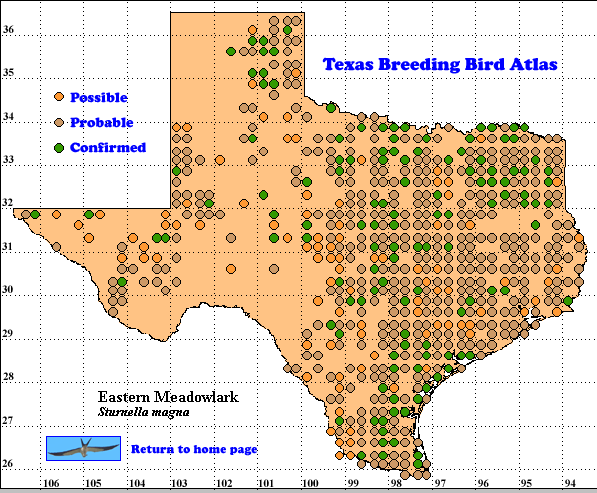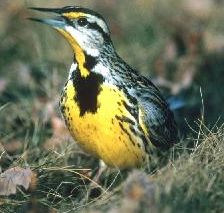Two or possibly three species of meadowlarks (actually blackbirds, not larks) reside in Texas with extensive range overlap between the Eastern and Western (S. neglecta) species. These two species were once considered conspecific, but Lanyon’s extensive work with captive birds (summarized in Lanyon 1995) showed that the two species are reproductively isolated. For distinguishing details see Lanyon (1995), Pyle (1997) and Colver (1999)..
The subspecies S. m. lilianae, which breeds in the southwestern United States from west Texas to Arizona and in northwest Mexico, can be distinguished from other subspecies of the Eastern Meadowlark and from Western Meadowlark vissually by the amount of white in the tail. Because of differences between S. m. lilianae and other meadowlarks, this subspecies is considered by some to be a separate species (Lanyon 1995).
DISTRIBUTION. As the TBBA map below shows there are two separate ranges for Eastern Meadowlark in Texas. In the eastern area west to a line from the 102nd meridian and the Oklahoma border to the 101st meridian at the Rio Grande River the magna group of subspecies is resident. The subspecies S. m. lilianae breeds and winters in the Trans-Pecos and southern High Plains regions.
In eastern North America the magna group of this species breeds from South Dakota to Nova Scotia and south to the Gulf Coast. This group also breeds in Middle America, northeastern South America and Cuba. In winter breeders from southeast Canada and adjacent northern states move southward (Lanyon 1995, Am. Ornithol. Union 1998).
SEASONAL OCCURRENCE. Eastern Meadowlark is a resident all year in both parts of its range in Texas. The species breeds in this state from early March to late August based on egg dates from mid-March to August 8 and TBBA field work where atlasers found a variety of breeding activities at the end of March. Breeding dates continued to late July (Oberholser 1974, Lockwood and Freeman 2004).
BREEDING HABITAT. Eastern Meadowlark breeds in Texas from near sea level to 1800 m (6000 ft) in tall grassy meadows and fields as well as savannas with grassy openings between trees. Careful identification of individuals by atlasers is necessary where the S. m. lilianae, the magna group and Western Meadowlark may be present since their habitats are very similar (Oberholser 1974, Corman 2005)
The nest of the Eastern Meadowlark is well-concealed on the ground, often in a shallow depression and usually in dense vegetation. The female gathers coarse and fine grasses (sometimes from a considerable distance) to form the cup which is sheltered under a dome or canopy of loosely interwoven grass. The outside diameter is 14-21 cm (5.5-8.5 in), inside diameter 8-15 cm (3-6 in). The nest is indistinguishable from that of Western Meadowlark (Harrison 1979, Lanyon 1995).
The female usually lays 4-5 (range 2-6) white, profusely marked eggs which are indistinguishable from those of Western Meadowlark. She incubates the eggs for 14-15 days and broods and feeds the nestlings for another 10-12 days. During this time the male may also gather some food for the nestlings. After fledging the young birds remain with there parents for 2 weeks. A female may raise 2 successful broods per year; Parasitism by Brown-headed Cowbirds (Molothrus ater) has been reported at rates as high as 16-24% ((Harrison 1979, Lamyon 1995).
STATUS. Texas has some of the highest relative abundances for Eastern Meadowlark in North America as measured on Breeding Bird Survey (BBS) routes. The Henrietta route in Clay County on the Rolling Plains was the 2nd high count in the BBS with an impressive average of 207 meadowlarks per 40 km (25 rni) route while the Gainesville route in Cooke County in the Post Oak Savannah and Blackland Prairies region was 3th with 156. (Price et al. 1995, Sauer et al. 2005).
Although Eastern Meadowlark is a common to locally uncommon bird in the eastern half of Texas (Lockwood and Freeman 2004), the BBS trend data is not encouraging for the future of this species. For the 1966-2005 period, data from 165 routes produce a statistically significant annual population change of -2.8%. The trend for 1980-2005 is -5.2%, far worse than the trend for the United States and Canada of -3.2% (Sauer et al. 2005).n Text by Robert C. Tweit (2006)
 Literature cited.
Literature cited.
American Ornithologists’ Union. 1998. Checklist of North American birds, 7th ed. Am, Ornithol. Union, Washington, DC.
Colver, K. J. 1999. Stokes field guide to birds songs – western region, Time Warner AudioBooks.
Corman, T. E. 2005. Eastern Meadowlark (Sturnella magna). In Arizona breeding bird atlas, pp.430-431 (T. E. Corman and C. Wise-Gervais, eds.), University of New Mexico Press, Albuquerque.
Harrison, H. H. 1979. A field guide to western birds’ nests. Houghton Mifflin, Boston, MA.
Lanyon, W. E. 1995. Eastern Meadowlark (Sturnella magna). In The birds of North America, No. 160 (A. Poole and F. Gill, eds.). The Birds of North America, Inc., Philadelphia, PA.
Lockwood, M. W. and B. Freeman. 2004. The TOS handbook of Texas birds. Texas A&M University Press, College Station.
Oberholser, H. C. 1974. The bird life of Texas, Vol. 2. University of Texas Press, Austin.
Price, J., S. Droege, and A. Price. 1995. The summer atlas of North American birds. Academic Press, New York.
Pyle, P. 1997. Identification guide to North American birds, part 1. Slate Creek Press, Bolinas, CA.
Sauer, J. R., J. E. Hines, and J. Fallon. 2005. The North American Breeding Bird Survey, results and analysis 1966-2004. Version 6.2 2006. USGS Patuxent Wildlife Research Center, Laurel MD (Web site, http://www.mbr-pwrc.usgs.gov/bbs).
